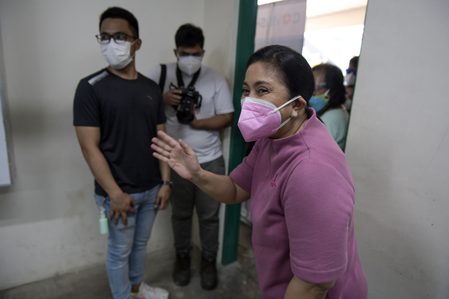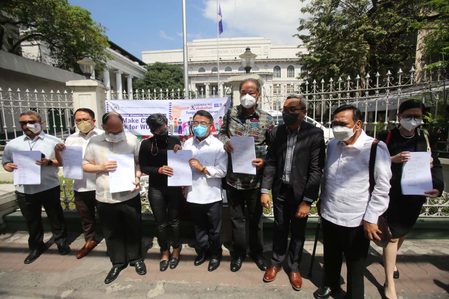Opinion piece posted to Rappler (Mar 22, 2022): [OPINION] Rethinking and renewing the GRP-NDFP peace talks in 2022 (SOLIMAN M. SANTOS JR)

'There can really be no genuine and meaningful peace negotiations until there is a paradigm shift on both sides'
Every advent of a new presidential administration in the Philippines, including for its election campaign prelude period, it has become fashionable to call for the resumption of peace talks between the Government of the Republic of the Philippines (GRP) and the National Democratic Front of the Philippines (NDFP), but strangely forgetting (unwittingly or wittingly) any call for a ceasefire. While such peace talks can be said to be in the best interests of the country, it has become increasingly clear that they cannot viably (or even should not) be conducted in the old way – perhaps just like what is said about revolutionary situations arising when the ruling class can no longer rule in the old way (but also perhaps something ought to be said too about when revolutions can or should no longer be conducted in the old way).
What then is the old and unviable way of the GRP-NDFP peace talks that has to be rethought and renewed so that its resumption does not become another exercise in futility? The most fundamental aspect of the old and unviable way are their respective overarching or operative frameworks. The avowed protracted people’s war (PPW) strategy and armed struggle primacy of the NDFP with its leading organizations the Communist Party of the Philippines (CPP) and the New People’s Army (NPA) subsumes the peace talks to only of tertiary, and consequently only tactical not strategic, importance (their authoritative issuances show this). If the real value of the peace talks for one side is only or mainly to draw certain tactical concessions that ultimately support the overall PPW strategy, then the sincerity of that side in the peace talks can be questioned, and it would be reasonable or understandable to do so.
On the other hand, the GRP’s operative framework to end the local communist armed conflict, at least under the outgoing Duterte administration, appears to be to end the local communists PERIOD. It is in effect a “military victory” policy position, and also partly or secondarily a “pacification and demobilization” policy position, but not at all an “institutional peace-building” policy position. Its proponents outrightly reject some election campaign calls for resumption of the peace talks, but referring to the existing or old way these have been conducted. Such rejection of “more of the same” is not without reason based on experience in the peace talks whereby the GRP perceives their merely tactical use by the CPP-NPA-NDFP to advance its PPW strategy – to the GRP, therefore, the CPP-NPA-NDFP “has failed to show sincerity and commitment in pursuing genuine and meaningful peace negotiations.”

There can really be no genuine and meaningful peace negotiations until there is a paradigm shift on both sides. This is of course easier said than done. It will likely take more needed time for each side to honestly, thoroughly, and creatively review and rethink their respective war and peace strategies. Surely, 53 years of armed conflict since 1969 still unresolved either way ought to be more than enough impetus for such a review and rethinking. This will entail much internal and closed-door discussions, but there is also a need to have room or space for more public discussions with stakeholders, concerned sectors, and resource persons. These two levels of discussion, internal and public, would be best pursued and facilitated in a purposive, proactive, and even programmatic manner, with the necessary infrastructure for such discussions. Of course, paradigm shifts can also come about due to certain relevant developments on each side and in the overall situation, including in the balance of forces. Leadership changes on both sides can be a factor but this will not be enough without the aforementioned efforts toward rethinking and renewal of the peace talks, and the necessary trust and confidence building.
Even a mutual, if at all, reaffirmation of the existing framework and related agreements for the peace talks – e.g. the 1992 Hague Joint Declaration, the 1995 Joint Agreement on Safety and Immunity Guarantees and its 1998 Additional implementing Rules, the 1995 Agreement on the Ground Rules of the Formal Meetings, the 1995 Joint Agreement on the Formation, Sequence, and Operationalization of the Reciprocal Working Committees and its 1997 Supplemental Agreement – will not be enough for genuine, meaningful, and viable peace negotiations without the aforesaid paradigm shifts and the necessary trust in each other side’s sincerity for a negotiated political settlement rather than “sincerity” for a politico-military victory over the other side with the peace process merely instrumentalized for this. The latter orientation would only negate the inherent character and purpose of the peace negotiations, and is tantamount to negotiating in bad faith. The above-mentioned honest review and rethinking should thus also cover the said existing framework and related agreements for the peace talks. This could or even should lead to any necessary improvement of the same as well as any necessary additional new agreements that rectify the extreme protraction of the peace negotiation – as there have in fact been attempts at this by both sides but gone to naught.
In the necessary review and rethinking that should be done by both sides of their respective war and peace strategies as well as of the existing framework and related agreements for the peace talks, they cannot and should not avoid problematizing what some consider “the elephant in the room” – the role or bearing of the Philippine Constitution that is the ultimate framework of the GRP. This underlying reality and the counterpart assertion by the NDFP of its own constitutional framework is indeed a challenge in constitutional problem-solving in the process of seeking creative constitutional solutions and making good, if not the best, constitutional choices. Many successful peace processes abroad, but also here with the two Moro liberation fronts (the MNLF in 1996 and the MILF in 2014), show that this “elephant in the room” problem can be creatively surmounted, including by deferring final political determinations, such as by a later referendum like for the Northern Ireland peace process.
But there may still be another “elephant in the room” brought in by the NDFP – its related assertion of a status of “co-belligerency in civil war.” Apart from the questionable currency of this old international law concept considered obsolete by many modern international law authorities, there may be application by analogy here of a standard provision in the 1949 Geneva Conventions and their 1977 Additional Protocol I, avowedly adhered to by both sides, that their application “shall not affect the legal status of the Parties to the conflict.” Instead, there might be adoption of the principle of “parity of esteem” from the Northern Ireland peace process which was in fact adopted for the MILF peace process.
On the other hand, the GRP side has also brought in its own “elephant in the room” in the form of the several successive “terrorist” designations of the CPP, NPA, and NDFP as well as certain related “front organizations” and personalities, such designations now governed by the new Anti-Terrorism Act (ATA) of 2020, the overall constitutionality of which was upheld by the Supreme Court in a Decision in December 2021. And the NDFP through its Chief Political Consultant Prof. Jose Maria Sison has posed apparent preconditions for the resumption of the peace negotiations (but which the outgoing Duterte administration does not want): the withdrawal of the said “terrorist” designations, the nullification of the ATA, and the dissolution of the rabid anti-communist National Task Force to End Local Communist Armed Conflict (NTF-ELCAC). The next presidential administration which would be the one to resume the peace talks, if ever, would likely have to grapple with these apparent preconditions of the NDFP.

In theory, the conventional wisdom is that “we do not negotiate with terrorists.” But in practice, it happens. It happened in the MILF peace process. And it happened more recently in the 2020 Agreement for Bringing Peace to Afghanistan between the US and its designated “foreign terrorist organization” the Afghan Taliban, but with the designation withdrawn upon the signing of that peace agreement. “Terrorist” designation in itself is not a decisive counter-factor against peace negotiations. There are other, more decisive factors, like lack of trust and confidence and the politico-military situation. The problem is that both sides here, the GRP and the NDFP, believe (or would like to believe) that they are winning the war, so no need to negotiate peace, without regard to those caught in the crossfire of continuing armed hostilities.
At this point, we may as well state that the above-mentioned honest review and rethinking by both sides on their respective war and peace strategies should include a “last resort” discussion on a Plan B, if there can be one, for the peace process (note, not just the peace talks) IF there are still no forthcoming paradigm shifts by one or both sides. In other words, given the latter and thus likely no genuine and meaningful peace negotiations, what kind and form of peace effort should and can be made? A menu of options for this can be found among the so-called “Six Paths to Peace” under old Ramos and Arroyo Executive Orders for government’s comprehensive peace efforts. It is not only “3. Peaceful Negotiated Settlement with the Different Rebel Groups;” it is also “1. Pursuit of Social, Economic and Political Reforms,” “2. Consensus-Building and Empowerment for Peace,” “4. Programs for Reconciliation, Reintegration into Mainstream Society and Rehabilitation, “5. Addressing Concerns Arising from Continuing Armed Hostilities,” and “6. Building and Nurturing a Climate Conducive to Peace.” There is also more to learn from other country peace processes, whether for Plan A or Plan B.
A crucial question might be, IF there are still no forthcoming paradigm shifts and no genuine and meaningful peace negotiations, can there be in the meantime some necessary trust and confidence building, at least something to start with that can be built on? We cannot overemphasize enough the importance of this aspect. With or without peace negotiations, there is merit to working out and having specific measures of goodwill and confidence building. A ceasefire can be seen in this regard, especially to create a favorable climate for peace negotiations. Much of the problematic peace talks conducted in the old way was to hold them without ceasefires in the spoiler-prone mode of “talking and fighting” at the same time. But the more fundamental sincerity and humanity question here is: if we are going to have a peace settlement anyway, why in the meantime waste irreplaceable lives arising from continuing armed hostilities? Is the common goal of the attainment of a just and lasting peace not also for those lives? Stated otherwise in the vernacular, aanhin pa ang damo kung patay na ang kabayo?
If there will be no peace talks and no ceasefire, the minimum trust and confidence building measure ought to be along the “fifth path to peace” of addressing concerns arising from continuing armed hostilities by better respect for human rights and international humanitarian law (IHL) by both sides, for which they already have a comprehensive agreement (the 1998 CARHRIHL) but whose implementation is impeded by an inherently stalemated Joint Monitoring Committee (JMC) mechanism. As this was operationalized in the old way, propaganda became more important than truth, and belligerency meant not only a subject of status obsession but also a hyper-adversarial mode of language. What ever happened to specific measures of goodwill and confidence building to create a favorable climate for peace negotiations? A better mechanism is one that includes the constitutionally independent Commission on Human Rights (CHR) as well as independent and competent civil society peace, human rights and IHL advocacy organizations, guided not only by the CARHRIHL but also by other available national and international terms of reference, most of the latter also mutually agreed or adhered to by both sides.
In fact, the matter of addressing concerns arising from continuing armed hostilities would be best addressed in both preventive and quick reaction terms at the local level, following the principle of subsidiarity, used again in the Northern Ireland peace process. These could very well be viable mechanisms of addressing such local concerns that are of course not matters of political negotiations and settlement at the necessary national level. The point is not to await or be dependent on the latter kind of peace process before being able to act quickly and effectively on humanitarian concerns arising from continuing armed hostilities affecting local communities. Honest-to-goodness local-level peace processes to address such humanitarian concerns are not of the same kind as the “localized peace talks” with a counter-insurgency “divide and rule” orientation, that by their nature cannot substitute for political negotiations necessarily undertaken at the national level. It goes without saying that honest-to-goodness local-level peace processes to address humanitarian as well as even public health (e.g. anti-COVID vaccination) and socio-economic (e.g. food security) concerns should entail the necessary safety and security safeguards for local CPP-NPA-NDFP representatives who may have to deal with local government and military officials, with the assistance of independent local civil society peace and humanitarian workers. There ought to be utmost good faith on both sides, if there is to be a starting point for trust and confidence building. And this simply has to start somewhere.
Related to local socio-economic concerns, after some necessary initial trust and confidence built, the honest-to-goodness local-level peace processes may consider, with some national level authorization on both sides, and with the necessary technical expertise and support, the piloting or experimentation of the possible recognition and legitimization of whatever applicable revolutionary land reform effected by the local CPP-NPA-NDFP. Whatever positive results from this piloting may serve as inputs for the national-level peace talks when ready and/or into agrarian reform legislation that would address the land problem root cause of the armed rebellion and conflict. In this way, some due recognition would be given to what may be considered a just cause or a legitimate social grievance. This approximates what is mentioned in the aforesaid old Ramos and Arroyo Executive Orders on a third principle of the comprehensive peace process that “seeks a principled and peaceful resolution to the internal armed conflicts, with neither blame nor surrender, but with dignity for all concerned.”
The idea of piloting or experimentation relates to at least two other ideas or concepts for a rethought and renewed peace process. One is the idea of testing first certain arrangements or compliance with interim agreements, including for a ceasefire, before adopting them on a wider scale and for a longer or more permanent duration. Another concept, applied in the MILF peace process, is incrementalism. A good international peace advocate friend, who was once involved in that peace process, points out that the understanding of what a peace agreement can and cannot achieve has also developed. Peace agreements are fundamental but insufficient in themselves to fully address structural problems of social injustice. They brought major change to South Africa in 1993, Northern Ireland in 1998 and Nepal in 2006. But deep problems remain in all these countries, even where former combatants eventually accessed government.
What is important, to again use wording from the aforesaid old Ramos and Arroyo Executive Orders on the second principle of the comprehensive peace process, is for peace agreements to AT LEAST “establish a genuinely pluralistic society, where all individuals and groups are free to engage in peaceful competition for predominance of their political programs without fear, through the exercise of rights and liberties guaranteed by the Constitution, and where they may compete for political power through an electoral system that is free, fair and honest.” The lessons from the coming May 2022 national and local elections should be perhaps the last country experience-based input into that long-overdue process of political, electoral, and even constitutional reforms. Such hopefully game-changing societal reforms exemplify the “first path to peace” that should be pursued through administrative action, new legislation or even constitutional amendments. The corresponding institutionalization of societal reforms may in turn help cause the necessary paradigm shifts in the war and peace strategies of both sides. Otherwise, as John F. Kennedy said, “Those who make peaceful revolution impossible, make violent revolution inevitable.” There are thus those who are “rabid,” Sison says, who “unwittingly help the armed revolution of the Filipino people.” But there are also those who are rabid who wittingly help the armed revolution. Both rabid paradigms have to change. – Rappler.com
[Soliman M. Santos Jr. is a long-time human rights and IHL lawyer; legislative consultant and legal scholar; peace advocate, researcher, and writer; author of a number of books; founding and long-time Coordinator, now Chair Emeritus, of the Philippine Campaign to Ban Landmines, and a member of the new Editorial Board of the prestigious International Review of the Red Cross. His views here are his own.]
https://www.rappler.com/voices/thought-leaders/opinion-rethinking-renewing-grp-ndfp-peace-talks-2022/

No comments:
Post a Comment
Note: Only a member of this blog may post a comment.